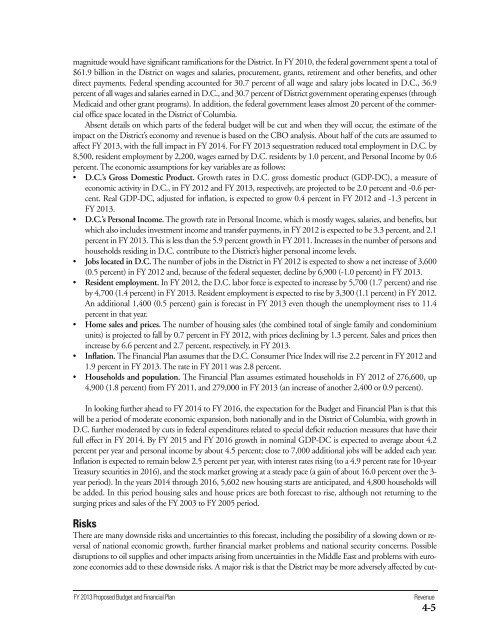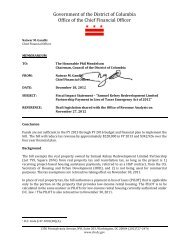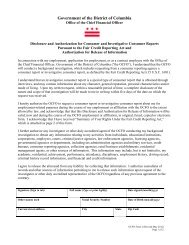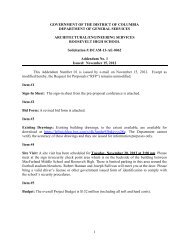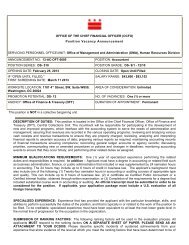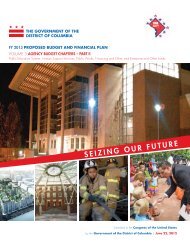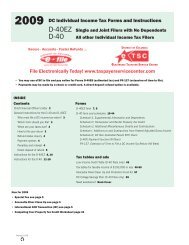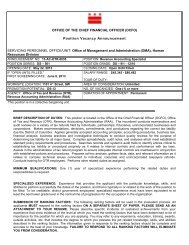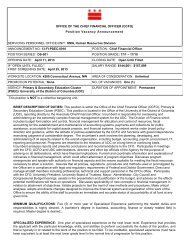Volume 1 - Executive Summary - Office of the Chief Financial Officer
Volume 1 - Executive Summary - Office of the Chief Financial Officer
Volume 1 - Executive Summary - Office of the Chief Financial Officer
Create successful ePaper yourself
Turn your PDF publications into a flip-book with our unique Google optimized e-Paper software.
magnitude would have significant ramifications for <strong>the</strong> District. In FY 2010, <strong>the</strong> federal government spent a total <strong>of</strong><br />
$61.9 billion in <strong>the</strong> District on wages and salaries, procurement, grants, retirement and o<strong>the</strong>r benefits, and o<strong>the</strong>r<br />
direct payments. Federal spending accounted for 30.7 percent <strong>of</strong> all wage and salary jobs located in D.C., 36.9<br />
percent <strong>of</strong> all wages and salaries earned in D.C., and 30.7 percent <strong>of</strong> District government operating expenses (through<br />
Medicaid and o<strong>the</strong>r grant programs). In addition, <strong>the</strong> federal government leases almost 20 percent <strong>of</strong> <strong>the</strong> commercial<br />
<strong>of</strong>fice space located in <strong>the</strong> District <strong>of</strong> Columbia.<br />
Absent details on which parts <strong>of</strong> <strong>the</strong> federal budget will be cut and when <strong>the</strong>y will occur, <strong>the</strong> estimate <strong>of</strong> <strong>the</strong><br />
impact on <strong>the</strong> District’s economy and revenue is based on <strong>the</strong> CBO analysis. About half <strong>of</strong> <strong>the</strong> cuts are assumed to<br />
affect FY 2013, with <strong>the</strong> full impact in FY 2014. For FY 2013 sequestration reduced total employment in D.C. by<br />
8,500, resident employment by 2,200, wages earned by D.C. residents by 1.0 percent, and Personal Income by 0.6<br />
percent. The economic assumptions for key variables are as follows:<br />
• D.C.’s Gross Domestic Product. Growth rates in D.C. gross domestic product (GDP-DC), a measure <strong>of</strong><br />
economic activity in D.C., in FY 2012 and FY 2013, respectively, are projected to be 2.0 percent and -0.6 percent.<br />
Real GDP-DC, adjusted for inflation, is expected to grow 0.4 percent in FY 2012 and -1.3 percent in<br />
FY 2013.<br />
• D.C.’s Personal Income. The growth rate in Personal Income, which is mostly wages, salaries, and benefits, but<br />
which also includes investment income and transfer payments, in FY 2012 is expected to be 3.3 percent, and 2.1<br />
percent in FY 2013. This is less than <strong>the</strong> 5.9 percent growth in FY 2011. Increases in <strong>the</strong> number <strong>of</strong> persons and<br />
households residing in D.C. contribute to <strong>the</strong> District’s higher personal income levels.<br />
• Jobs located in D.C. The number <strong>of</strong> jobs in <strong>the</strong> District in FY 2012 is expected to show a net increase <strong>of</strong> 3,600<br />
(0.5 percent) in FY 2012 and, because <strong>of</strong> <strong>the</strong> federal sequester, decline by 6,900 (-1.0 percent) in FY 2013.<br />
• Resident employment. In FY 2012, <strong>the</strong> D.C. labor force is expected to increase by 5,700 (1.7 percent) and rise<br />
by 4,700 (1.4 percent) in FY 2013. Resident employment is expected to rise by 3,300 (1.1 percent) in FY 2012.<br />
An additional 1,400 (0.5 percent) gain is forecast in FY 2013 even though <strong>the</strong> unemployment rises to 11.4<br />
percent in that year.<br />
• Home sales and prices. The number <strong>of</strong> housing sales (<strong>the</strong> combined total <strong>of</strong> single family and condominium<br />
units) is projected to fall by 0.7 percent in FY 2012, with prices declining by 1.3 percent. Sales and prices <strong>the</strong>n<br />
increase by 6.6 percent and 2.7 percent, respectively, in FY 2013.<br />
• Inflation. The <strong>Financial</strong> Plan assumes that <strong>the</strong> D.C. Consumer Price Index will rise 2.2 percent in FY 2012 and<br />
1.9 percent in FY 2013. The rate in FY 2011 was 2.8 percent.<br />
• Households and population. The <strong>Financial</strong> Plan assumes estimated households in FY 2012 <strong>of</strong> 276,600, up<br />
4,900 (1.8 percent) from FY 2011, and 279,000 in FY 2013 (an increase <strong>of</strong> ano<strong>the</strong>r 2,400 or 0.9 percent).<br />
In looking fur<strong>the</strong>r ahead to FY 2014 to FY 2016, <strong>the</strong> expectation for <strong>the</strong> Budget and <strong>Financial</strong> Plan is that this<br />
will be a period <strong>of</strong> moderate economic expansion, both nationally and in <strong>the</strong> District <strong>of</strong> Columbia, with growth in<br />
D.C. fur<strong>the</strong>r moderated by cuts in federal expenditures related to special deficit reduction measures that have <strong>the</strong>ir<br />
full effect in FY 2014. By FY 2015 and FY 2016 growth in nominal GDP-DC is expected to average about 4.2<br />
percent per year and personal income by about 4.5 percent; close to 7,000 additional jobs will be added each year.<br />
Inflation is expected to remain below 2.5 percent per year, with interest rates rising (to a 4.9 percent rate for 10-year<br />
Treasury securities in 2016), and <strong>the</strong> stock market growing at a steady pace (a gain <strong>of</strong> about 16.0 percent over <strong>the</strong> 3-<br />
year period). In <strong>the</strong> years 2014 through 2016, 5,602 new housing starts are anticipated, and 4,800 households will<br />
be added. In this period housing sales and house prices are both forecast to rise, although not returning to <strong>the</strong><br />
surging prices and sales <strong>of</strong> <strong>the</strong> FY 2003 to FY 2005 period.<br />
Risks<br />
There are many downside risks and uncertainties to this forecast, including <strong>the</strong> possibility <strong>of</strong> a slowing down or reversal<br />
<strong>of</strong> national economic growth, fur<strong>the</strong>r financial market problems and national security concerns. Possible<br />
disruptions to oil supplies and o<strong>the</strong>r impacts arising from uncertainties in <strong>the</strong> Middle East and problems with eurozone<br />
economies add to <strong>the</strong>se downside risks. A major risk is that <strong>the</strong> District may be more adversely affected by cut-<br />
FY 2013 Proposed Budget and <strong>Financial</strong> Plan<br />
Revenue<br />
4-5


